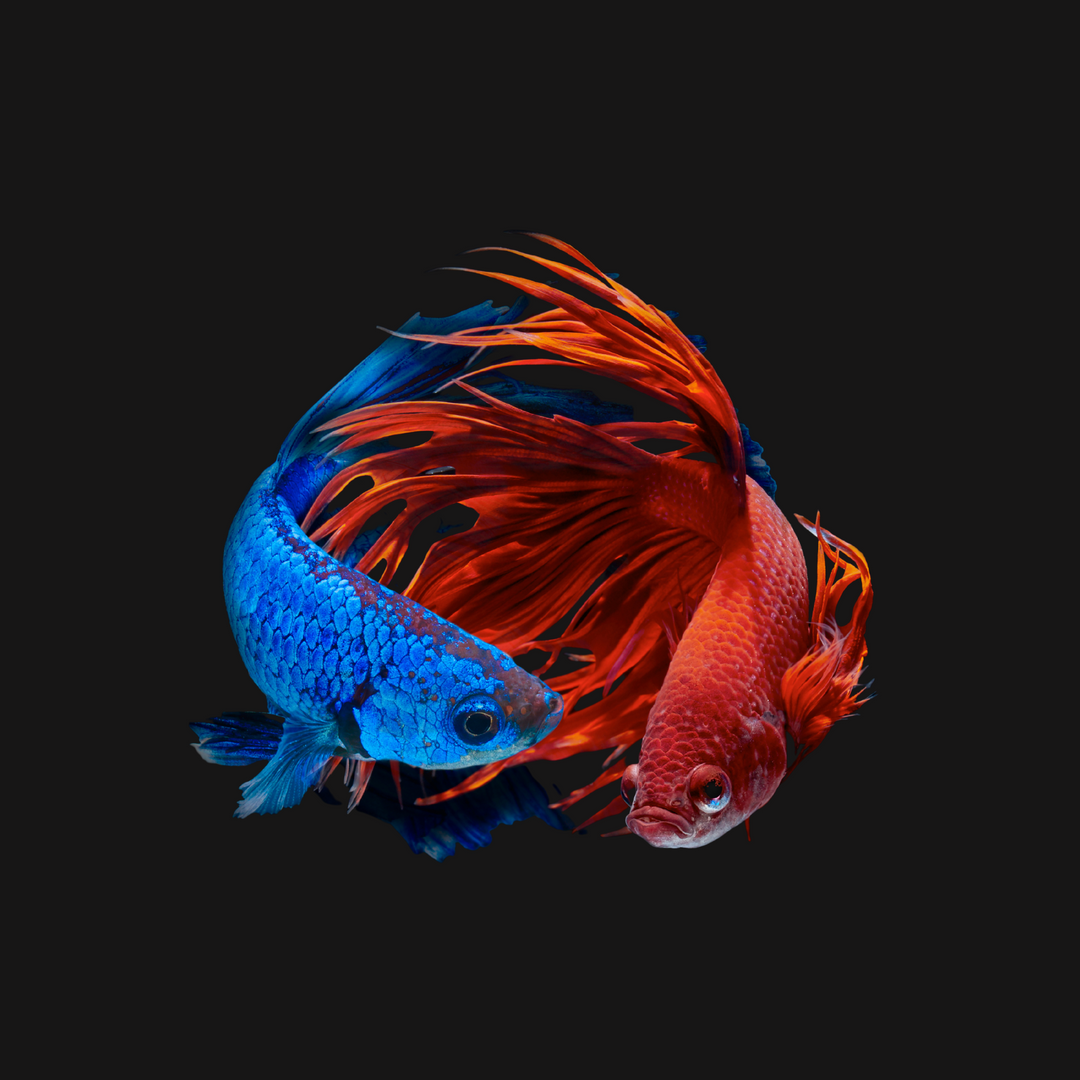Giant Betta vs. Normal Betta

If you are an aquarium enthusiast, you may be confused between the many varieties of betta fish. Among them, the difference between giant betta and common betta is a common question. The only difference is the size between them.
Let's explore the size differences between these betta varieties to help you make the right choice for your aquarium.
The World of Bettas: An OverviewCommon Betta
Giant Betta
Differences between Common Betta and Giant Betta
Common diseases in regular bettas and giant bettas
Q&A

The World of Bettas: An Overview
To truly understand the history of bettas and the differences between the hundreds of types, it is essential to know a little about the history and cultural traditions of this popular fish.
It all started in Southeast Asia, where cultural influences created changes that led to the creation of different varieties, including the impressive giant bettas.
Many species of bettas originate from still and shallow waters in Southeast Asia, especially Thailand.
People domesticated these fish more than 1000 years ago. Initially, they were fighting fish. The first bettas selected were aggressive and resistant. With these selections about behavior, breeders saw that other characteristics emerged, such as larger fins and more showy colors.
Over time, interest in bettas increased, and in addition to the characters of fighting fish, a new niche of appreciation for these animals emerged: beauty and diversity. Local breeders began to select fish to develop new colors and patterns, creating the first ornamental aquarium strains.
With the advancement of success, knowledge, and technologies associated with selective breeding, these fish have become what they are today, available in many colors, sizes, and patterns, each with their distinct colors and patterns. From fish with long tails to shortfin plakats.
Breeders created huge bettas, known today as giants through selection and reproduction. The first giant bettas date back to the early 1990s.

Common Betta
Common betta comprises various colors and fins of the fish scientifically known as Betta splendens. It's the most common betta variety and the most enhanced.
The original common betta is the wild betta fish, presenting an almost monochromatic color with intense brightness and short fins, similar to what we know today as plakat.
Appearance of the common betta
The aquarium varieties known as common betta do not exist in nature. These fish are the result of artificial selection in aquariums. Crown tail, longtail, koi, dragon are examples of varieties.
B. spendens are a medium-sized species, averaging 2 inches in size.
The most notable feature of common bettas is their wide variety of colors. There are hundreds of patterns and combinations of colors and patterns. Sparkling colors like green, blue, red, white, yellow, etc., can even be mixed in a harmonious and symmetrical pattern throughout the fish's body.
These patterns show all the work that breeders have done over the years, selecting and reproducing matrices that create a unique combination of colors and shapes.
Common betta behavior
In addition to their beauty, common bettas are known for an active behavior and captivating personality. They are curious fish who often interact with their owners and the environment. This curiosity probably comes from its territorial behavior, to ensure the fish is free from threats and recognizing friendly beings and objects.
Its size, incredible colors and ease of maintenance made this fish popular in the aquarium trade and hobby.

Giant Betta
Giant Betta are a variety that originated from regular bettas due to artificial selection. These fish have the same characteristics as common bettas but with a gigantic size.
Only aquarists with experience and previous knowledge of bettas should keep giants, as they are not for beginners.
Appearance of the giant betta
Common bettas rarely exceed 2.5 inches in size. Giant bettas, on the other hand, were selected for their large size, in addition to being bred in large spaces and excellent water quality, which makes them reach up to 5 inches in length.
This huge size is incredible for a betta fish making them more than a standout among the hundreds of types selected from the common betta.
Giant bettas are striking fish due to their size and colors. Breeders are constantly improving these fish, resulting in dozens of types of giant betta with many colors and fins.
Although giant bettas were generated from plakat bettas, these fish have long, fluid fins, with varieties such as the longtail.
Giant bettas also come in a wide variety of colors and patterns, worthy of extensive selective breeding work.
On our blog, you will find an article talking only about the types of betta fins, see in
Giant betta behavior and care
These huge bettas have the same active, territorial, and curious behavior as common bettas, with some individuals being more aggressive.
Know all of these fish in our article Giant Betta Fish Complete Guide

Differences between Common Betta and Giant Betta
When considering whether to keep a regular or a giant betta for your aquarium, you must understand the main differences between these two varieties.
Morphological differences between common betta and giant betta
The most notable difference between these bettas, as their name suggests, is their size. While regular bettas generally grow to around 2 inches, giant bettas can reach an impressive 5 inches.
Other morphological characteristics do not differ so much. Both fish have the same colors and fins concerning the pattern they present. Regular Bettas may have fins that are larger about their body.
As for colors, both common and giant bettas come in a multitude of colors and patterns.
Behavioral differences between common betta and giant betta
In terms of personality and behavior, both bettas share common characteristics. The territorial and aggressive nature is a trademark of the species.
Despite being territorial, they can be good fish for community aquariums, as some fish are incredibly sociable.
Male and female differences between common betta and giant betta
The differences between male and female fish are the same in all betta varieties. Females can live in groups when in large aquariums (over 20 gallons) with enough space for them all.
We should only keep one male per aquarium, otherwise, they will fight to the death.
If you want to know more about the differences between the sexes, visit our article Giant Female Betta vs. Giant Male Betta.
Differences in the care of common betta and giant betta
Both fish have the same basic care guidelines, with the same water requirements. Keep the pH around 7 and tropical temperature (72 - 77F).
Due to the enormous size of giant bettas, these fish require larger volume tanks. Regular bettas can live in 5 gallons of water, while giant bettas require tanks over 10 gallons.
Bettas thrive best in environments suitable for them, with decorations, heating, a filtration system, and enough space to explore and hide.
Decoration, although not essential, influences the well-being of the fish. The use of natural plants, driftwood, rocks, and leaves brings a natural aesthetic to the tank, leaving the fish more at ease.
With the help of decoration, we can create low-light areas, caves, hiding places, and different environments for the fish to remain active and happy.
Common diseases in regular bettas and giant bettas
Both the common betta and the giant betta, as long as they are living in an ideal environment, are resistant fish and are unlikely to get sick.
Both are predisposed to suffering health problems when exposed to irregular or poor-quality water conditions. Giant bettas can suffer from digestive problems such as bloating when overfed or given the wrong diet.
Differences in diet between common betta and giant betta
Both are carnivorous fish, which require a varied diet, made up of commercial foods such as pellets with the supplementation of live and fresh foods such as nauplii, earthworms, brine shrimp, etc.
As previously mentioned, giant bettas can suffer from a diet with large foods, or excessive feeding, becoming obese and suffering from intestinal problems. Common bettas do not always have these problems.
To make sure your fish are eating correctly, offer small foods, approximately the size of the fish's eye, at least twice a day.
Q&A
1. What is the size difference between common bettas and giant bettas?
The difference in size between common bettas and giant bettas is notable. Common bettas usually grow to 2 inches, while giant bettas can reach an incredible 5 inches.2. Do I need a bigger aquarium to keep giant bettas?
Yes, due to the size of this fish, you need a larger aquarium to keep giant bettas. Use an aquarium of at least 10 gallons for a giant betta.3. Are giant bettas more aggressive than regular bettas?
Giant bettas can be more aggressive than regular bettas, but this is not a rule. Aggressiveness varies from fish to fish, regardless of the variety. To know if your fish is too aggressive, monitor its behavior.4. Are regular bettas suitable for smaller aquariums?
Common Bettas are suitable for smaller aquariums, starting at 5 gallons5. Can I keep common bettas and giant bettas together in the same aquarium?
No, never keep common bettas and giant bettas together in the same aquarium. These fish are aggressive and will fight. Furthermore, giant bettas are significantly larger and can easily hurt regular bettas.6. Where to buy giant betta fish?
Looking to add regal King or Giant Batta fish to your aquatic family? Dive into our enchanting Giant Betta Collection now!.





Leave a comment